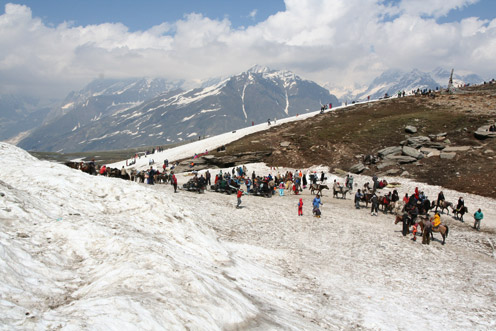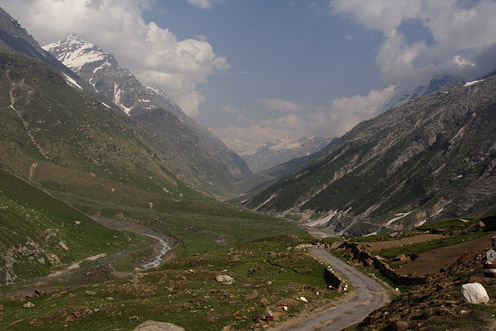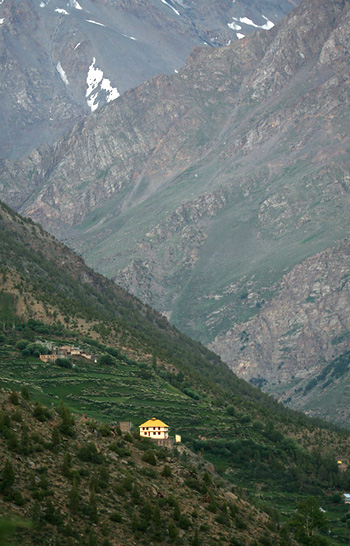People start from Manali at an unearthly hour of 2am. And they keep going and going and going, travelling nearly twenty hours to get to Leh. It seems like a senseless adventure to go in a cramped Tata Sumo in those testing altitudes; It seems like Leh will never come. But people do it: many Sumos leave for Leh everyday, packing passengers from Manali who don’t want to waste a day or spend more money by stopping on the way.
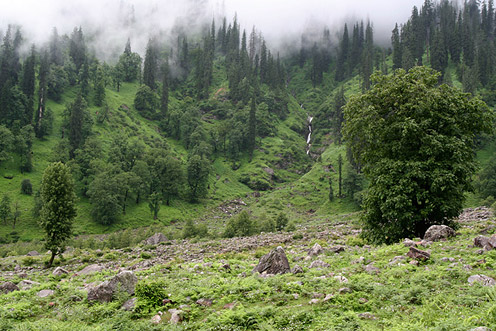
Verdant landscapes of Beas Valley
The initial part of the journey is pleasant. The road runs upstream of Beas River through a green valley, with tall mountains on both sides flaunting coniferous forests on their slopes. It slopes up gently for the first half hour and then steadily increases in gradient. Waterfalls run abundant on the near vertical slopes, emerging out of the snow trapped in depressions. The sheer scale of mountains in these parts are realized by tiny specs of shepherd-tents that look no bigger than a small dot on the slopes. It indeed needs no less than a collision between two continental masses to create formations of this scale and might. Its grandeur, size and fearsome weather can overwhelms the onlooker and instantly earn his or her respect.
The slopes of Manali-Rohtang Pass road remain green through the year in lower regions. The deodar forests give way to shorter vegetation higher up, and eventually it is just green grass spreading thinly on the surface. Streams run all over the place uncontrolled, released from the melting masses of ice. The pass is completely covered in snow in early summer and gradually melts away, with very little of it left when the monsoons arrive. As the first rains come in and snow is drained out from the higher regions, flowers burst out on the slopes, filling up every inch of the mountains with tiny dots of pink and yellow.
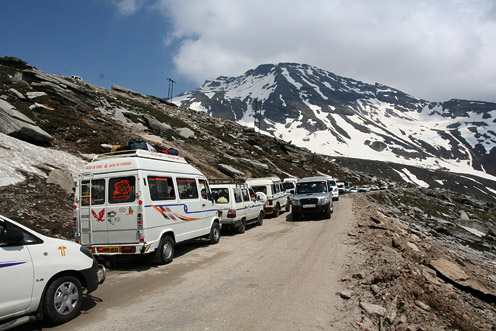
The road to Rohtang Pass (File Photo)
The last hour of the journey though, is much more than the romance with the mountain ranges. The rush of tourists in search of snow creates frequent traffic jams on the way up. Unmetalled surface can be slushy and hard to navigate. The thin mountain air and the half burnt diesel emissions from the pile of vehicle heading up is not exactly pleasant. It looks no different from peak hour traffic in congested roads of our cities, save for the views of the mountains here.
Tourists at Rohtang Pass (File Photo)
In summer months when there is still snow, Rohtang attracts large crowds excited about the snow. It’s a mad tourist trap that takes in thousands of people, followed by hundreds of vendors trying to keep the tourists comfortable and happy. The plateau on the pass turns into a big market place with long lines of shacks selling things from Aloo Paratha to skiing lessons. But later in the season when the slopes are bare (this is when the Ladakh season begins, in late June), there are just a handful of optimistic tourists searching for last of the snow.
Beyond Rohtang: Chandra Valley in Lahaul (File Photo)
However, there is a sea change in atmosphere on getting past Rohtang and entering into the valley of Chandra river in Lahaul region. The greenery that kept comapny disappears suddenly and the slopes appear brown and arid. Dhauladhar mountains (the mountain range that hosts Rohtang Pass) keep the monsoon at bay, allowing little precipitation and extending the summer days until October. The mass of tourists, the traffic and commotion dies down and makes way to silence. Verdant landscapes of Beas Valley make way to a stark beauty that has no parallels to scenery witnessed so far. It is here that the traveller begins to see first glimpses of barren landscape that Ladakh is, though Ladakh itself is still far away.
+ The next few posts in the Ladakh series will focus on traversing the Manali – Leh highway. These posts will cover transport options from Manali, what to see, where to stop, and everything else you would want to know when taking this route.
+ The prices mentioned here are as of 2008. Please factor in inflation!
It is the difficulty involved in traversing the road that attracts travelers to make the journey from Manali to Leh by road. Nowhere else in India do you get to drive hundreds of kilometers without seeing a single permanent habitation. The road runs above ten thousand feet for almost entire journey, and the highest point on the road is above 18,000 feet. The landscapes are unparalleled. The superb greenery on the way out of Manali will be the last stretch of abundant vegetation that you encounter until the day you return from Ladakh.
The journey is hard by itself, and very often the mode of transport chosen can make things harder.
The Delhi – Leh Bus
It took some time to register in my mind that there really is a bus that goes all the way from Delhi to Leh. It is an ordinary bus with 2+3 seats, run by Himachal Road Transport Corporation. It is the cheapest way to get to Leh, and probably the most uncomfortable. It arrives in Manali around 10am and leaves an hour later for Keylong. Reaching Keylong by 5pm, the bus continues towards Leh next morning, arriving at the destination in the evening. Most of the time it will be crowded when it arrives in Manali. If you are lucky, you might find a few seats unoccupied in the last row when the bus leaves Keylong.
The first hotel we looked up on arriving at Keylong did not have any rooms available. So did the second, third and the fourth. The one hotel which could take us in was the most expensive in town. I must have spent a good thirty minutes without much luck, searching through all the hotels near Mall Road. It is not the best feeling – having arrived in some remote town in the middle of the mountains, faraway from everything, only to find out that there is no place to stay. A supposedly nice guesthouse recommended by a friend was closed for good, rented out to house the offices of a government body. The options left, it seemed, were the most expensive and the least expensive. The latter was a bunch of grubby dorms near the bus-stand, mostly used by passengers who take the Delhi-Leh bus that halts for the night in Keylong.
A House on the Slopes of Keylong
It helped making some inquiries at the mall road before resigning to the expensive place. A recommendation by a friendly man (who worked at one of the hotels that was full) lead us towards the old bus stand, along the mall road for a quarter kilometer and then a steep climb through long series of steps. The heavy backpack weighing a dozen kilogram, along with the thin mountain air made it all seem like work. But the place we stumbled into was just how we would like it – clean rooms and loo with wide windows opening up to views of the mountains and the Bhaga Valley. The place was good enough to keep us stay put for four days.
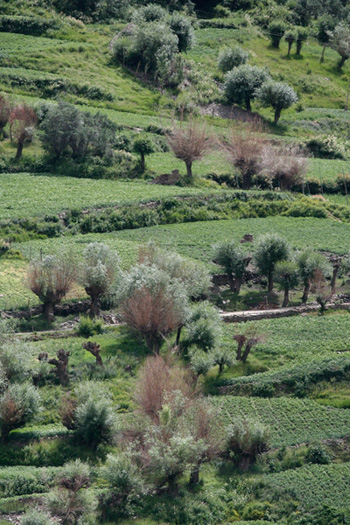
Slopes of Keylong
Of the four days in Keylong, the first was spent visiting the ancient temple filled with fine wood carvings in Udaipur village. Another day was spent gallivanting in Keylong, and the day after that was a festival in Shashur monastery. On the third day we realized we were running out of money! We had forgotten to draw cash at Manali, the last place to find an ATM on the way. So the evening and the next day have to be spent trying to find ways to get to Leh with whatever money was left. The Delhi-Leh bus, discomfort at its best, was the cheapest option, but even that was completely booked. After running around for sometime in search of all possible options, a kind travel agent let us book a shared taxi, accepting only part of the money in advance. The rest was to be paid once we got to Leh, drawing money at one of the ATMs in the market. We were to find out later that it was not as simple as it seemed. And being penniless meant we had to travel direct to Leh, without stopping anywhere on the way. The plan to break the journey at Sarchu, Pang and any other place we wished to on the way, was not to happen.


